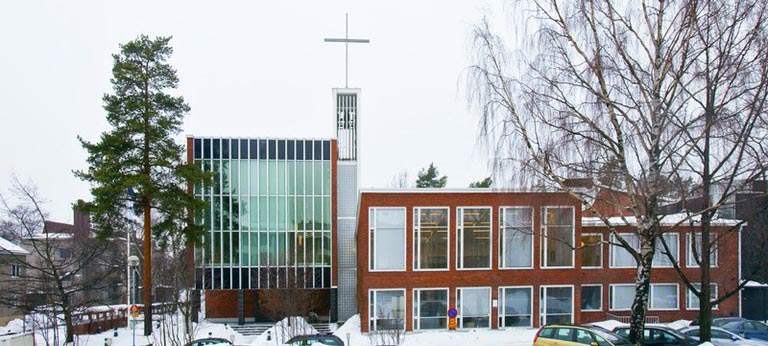Pitäjänmäki church

In 1936, Pitäjämäki was moved from the Helsinki parish to Huopalahti parish, which was joined to Helsinki in early 1946. The community of Pitäjämäki became a district of Helsinki. Designed by architects, Olli and Eija Saijonmaa, the Pitäjämäki church was completed in spring 1959. It was a chapel of the Huopalahti parish until Pitäjämäki became its own parish in 1966.
The auxiliary facilities built in connection with the church, such as a two storey high gym, bear witness to the ideals of parish activities of the time when the church was built. The church is separated from the parish centre with extensive window surfaces, decorated with copper mouldings. The top part of the entrance rises as an echo of the west tower of a traditional rectangular church. The bell tower is made of concrete; the other façades have brick facings.
The wooden cross in the church was replaced in 1966 with the altarpiece, Taivasten valtakunnan kevät (Spring in the Kingdom of Heaven), by artist and graphic designer, Pär Erik Granfelt. The old wooden cross war returned to its place in 1989 and the altarpiece was moved to the parish meeting hall.
The church was renovated and extended in 2005–2006. A stairwell with a lift was built in the corner of the church and parish centre sections, and the gym was divided into two floors. Office premises were built on the second floor with a youth centre in the basement. On the second floor of the church building are two parish meeting halls, a room with a fireplace and a kitchen, with club facilities for school-aged children on the third floor. New church textiles were introduced in association with the renovation.
The Kangasala organ factory made the church organ in 1976. The mechanical organ has seventeen stops and two keyboards.
The model of the Pitäjänmäki cenotaph, a plaster relief donated to the parish on Independence Day, 1968, was moved from the lower lobby of the church to the second floor after the renovation. The cenotaph itself is at the Pitäjämäki soldiers’ cemetery near Henrikintie and Kyläkirkontie, on the border of Helsinki and Espoo. Made of red Vehmaa granite, the cenotaph was designed by sculptor, Viljo Savikurki. The cenotaph bears the engraving, Pro Patria 1939-1945 (For their country 1939-1945). Twenty soldiers who died in our wars are buried in the soldiers’ cemetery.
The Pitäjämäki church is used by the Pitäjämäki parish.
Celebrations at the church
Members of the church can organise a baptism, a wedding or a funeral free of charge in the church.
The church seats 210 and the organ gallery 80.
There are two parish meeting halls. The larger hall has 80 seats and the smaller one has 40 seats at tables. The halls can be combined. The kitchen has coffee and dinner tableware for a hundred people.






